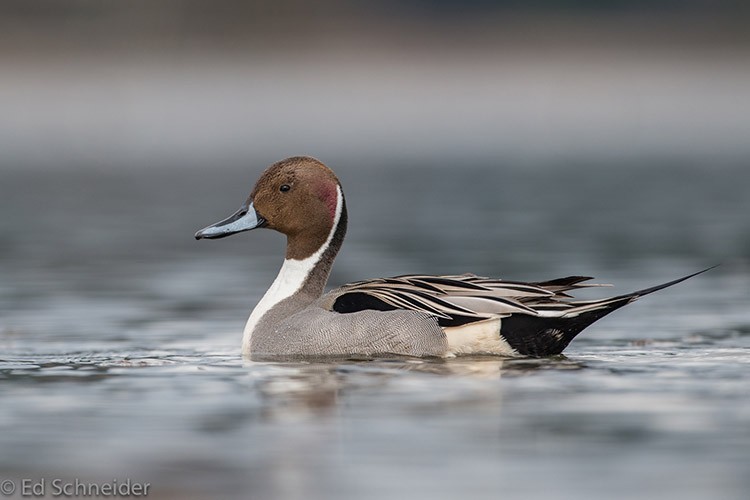Northern Pintail, Anas acuta

The male Northern Pintail is a most elegant dabbling duck* with its long slender white neck, and long central black tail feathers. Even the mottled brown female can be recognized by her graceful, long-necked shape.
The breeding distribution of the Northern Pintail is circumpolar. In North America, the core-nesting habitat is in Alaska and the prairies of central Canada, south to the northern Great Plains. Northern Pintails winter from the central United States southward to northern South America. This species also breeds in northern Eurasia wintering in southern Europe, Africa, and southern Asia.
In Tennessee, the Northern Pintail is most easily found during migration with smaller numbers over-wintering in the state.
Description: The male is boldly patterned with a white chest and neck, and a white stripe extending into the side of the chocolate-brown head. It has a long neck and long central tail feathers giving it a “pintail”.
The female has a long neck, and is mottled brown overall with a plain, slightly paler, head.
Length: 21"
Wingspan: 34"
Weight: 1.8 lbs.
Voice: The female quacks, but not as loud as a Mallard. The courting male gives a high, drawn-out whistle.
Similar Species:
- The male patterning is distinctive and no other female dabbling duck has such a long thin neck and a plain tan face.
Habitat: In Tennessee, pintails are found on lakes, ponds and in flooded grain fields.
Diet: Crustaceans, aquatic insects, and snails, grain, seeds, and weeds.
Nesting and reproduction: There are no known nesting records for this species in Tennessee.
Status in Tennessee: The Northern Pintail is a fairly common migrant and uncommon wintering duck in the state. They arrive in late August and become less numerous during the winter. Spring migrants arrive by mid-February and most birds depart by late March.
Dynamic map of Northern Pintail eBird observations in Tennessee
Fun Facts:
- Northern Pintails form new pair bonds each winter, but are highly promiscuous during the nesting season.
- Northern Pintails arrive on the breeding grounds shortly after the ice melts, earlier than most other North American ducks. They are also early fall migrants, and arrive on the wintering areas as early as August.
- The oldest known Northern Pintail in the wild was 22 years and 3 months old.
- A male pintail was recovered by a hunter in the delta of Mississippi after being banded 7 years before in southern Japan. There have been only a handful of Japanese banded birds recovered in the United States and this was the first from the southeast.
Obsolete English Names: American pintail, common pintail, sprigtail
Best places to see in Tennessee: wildlife viewing areas across the state including Reelfoot Lake, Cross Creeks NWR, Tennessee NWR, and others.